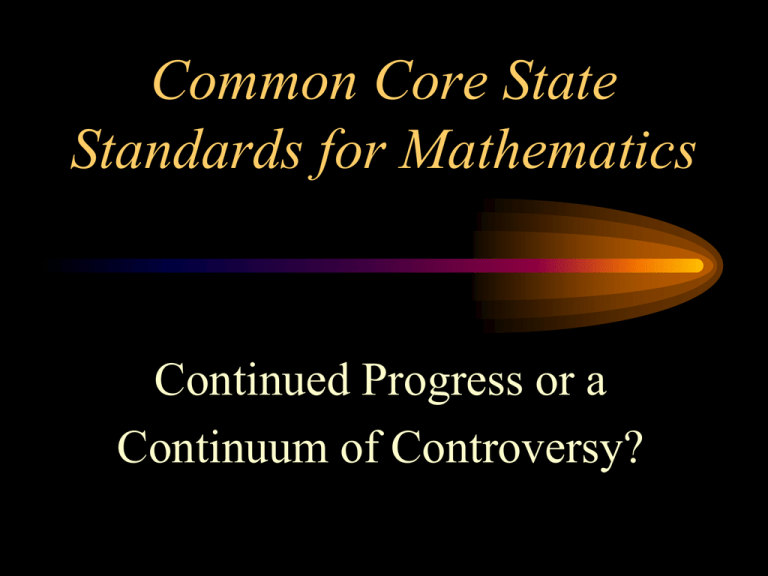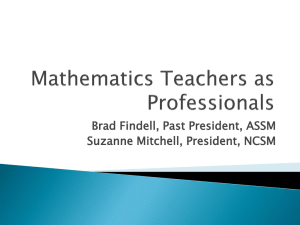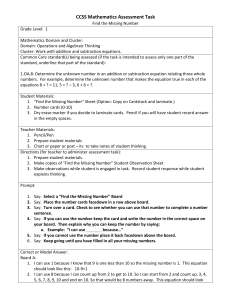Common Core State Standards for Mathematics
advertisement

Common Core State Standards for Mathematics Continued Progress or a Continuum of Controversy? Outline for the next hour • What is the Common Core? • What are the Goals of the CCSSM ? • What is the Controversy About? • What is the Basis for the CCSSM? • How are our students doing now? The Common Core State Standards ARE: • A listing of what K-12 students should know and be able to do in mathematics at the conclusion of each of the K-12 grades. • A set of objectives that should constitute 85% of the math programs in all states and jurisdictions that have adopted them. • An accepted basis for building curricula. The Common Core State Standards ARE NOT: • • • • A FEDERAL PROGRAM A CURRICULUM An ASSESSMENT SYSTEM A SPECIFICATION OF TEACHING METHODS ALTHOUGH THEY COULD BE COMPONENTS OF EACH ONE OF THESE! LET’S LOOK AT THE STANDARDS Who Created the CCSSM? • NATIONAL GOVERNORS’ ASSOCIATION • COUNCIL OF CHIEF STATE SCHOOL OFFICERS (CCSSO) Funding came from the STATES, and the: • Bill & Melinda Gates Foundation, National Education Association, & American Federation of Teachers Who Wrote the CCSSM? • A Committee of 20+ individuals from mathematics and mathematics education. • Supported by a Feedback Group of 20+ with long histories in mathematics & mathematics education. • Bill McCallum, Distinguished Professor of Mathematics at U of AZ chaired the writing. CCSSM Development Timeline • 1991 Time for Results: The Governors Report on Education, followed the release of NCTM Standards, the Governors called for better report cards of results about what student know & can do. • 2007 the Chiefs discuss developing common standards for the states. • 2008 the Chiefs, NGA, and Achieve release Benchmarking for Success: Ensuring U.S. Students Receive a 1st Class Education which focused being globally competitive. • 2009 Chiefs moved to CCSSO initiative and invited states to indicate interest—48 states did—and writing began in earnest with 3 rounds of feedback and state reviews. In mid-summer a draft of College and Career Readiness standards was circulated and work began on K-12 standards. Soon after this the DoEd announced its Race to the Top program. • Sept. 2009—Release Draft C&CR Standards to States and Feedback Group. October 2009 Feedback Round. Nov. 2009—Release Draft K-12 Standards to states and Feedback Groups, as well as to several selected independent reviewers for in-depth reviews. Feb. 2010—Distributed revised version of K-12 Standards and College and Career Readiness Standards to states, educators, public, and validators. Third Feedback Round. June, 2010—CCSSO and NGA release CCSS • Sept. 2011-13—States & jurisdictions review the CCSS, adapting, adopting, and ratifying CCSSM. • By Dec. 2013, 45 states, D.C., DoDEA, Guam, North Mariana Islands, and U.S. Virgin Islands had adopted the CCSSM. Alaska, Minnesota, Nebraska, Texas, & Virginia opted out. • By Feb. 2015, political backlash led to three adopting states rescinding adoptions: Indiana, Oklahoma, and South Carolina. This leaves 42 states as of this morning having supporting the CCSSM. Looking at the parts of CCSSM: Standards for Mathematical Practice • Make sense of problems & persevere in solving them. • Reason abstractly & quantitatively. • Construct viable arguments & critique the reasoning of others. • Model with mathematics. • Use appropriate tools strategically. • Attend to precision. • Look for & make use of structure. • Look for & express regularity in repeated reasoning. Looking at the Parts of CCSSM: Standards for Mathematical Content— Kindergarten • • • • • Counting and Cardinality – Know number names and the count sequence. – Count to tell the number of objects. – Compare numbers. Operations and Algebraic Thinking – Understand addition as putting together and adding to, and understand subtraction as taking apart and taking from. Number and Operations in Base Ten – Work with numbers 11–19 to gain foundations for place value. Measurement and Data – Describe and compare measurable attributes. – Classify objects and count the number of objects in categories. Geometry – Identify and describe shapes. – Analyze, compare, create, and compose shapes. Where Did We Get Our Standards? Commission on Post War Plans 1944-1947 • First major mathematics report in our times on school mathematics was the Commission on Post War Plans that responded to Adm. Nimitz’s concerns over mathematical readiness and was done by the NCTM • Three Commission Reports – 1st General recommendations – 2nd Specific Recommendations Kind.—C.C. – 3rd Guidance counselors, parents, administrator First Thesis of the Commission • The first thesis of the Post-War Commission was an overarching statement for teachers at all grade levels. It stated that “the school should guarantee functional competence in mathematics to all who can possibly achieve it” by outlining “the mathematics of the core curriculum”. The commission listed 28 different mathematical topics describing “the essentials for functional competence in mathematics”, including topics from number and operation, algebra, geometry, & business mathematics. Standards for Mathematical Content— Grade 4 • Operations and Algebraic Thinking – Use the four operations with whole numbers to solve problems. – Gain familiarity with factors and multiples. – Generate and analyze patterns. • Number and Operations in Base Ten – Generalize place value understanding for multidigit whole numbers. – Use place value understanding and properties of operations to perform multi-digit arithmetic. • Number and Operations—Fractions – Extend understanding of fraction equivalence and ordering. – Build fractions from unit fractions by applying and extending previous understandings of operations on whole numbers. – Understand decimal notation for fractions, and compare decimal fractions. Standards for Mathematical Content—Grade 4(cont.) • Measurement and Data – Solve problems involving measurement and conversion of measurements from a larger unit to a smaller unit. – Represent and interpret data. – Geometric measurement: understand concepts of angle and measure angles. • Geometry – Draw and identify lines and angles, and classify shapes by properties of their lines and angles. Elaborations of Standards: Mathematical Content—Grade 4 • Number and Operations in Base Ten – Generalize place value understanding for multidigit whole numbers. – Use place value understanding and properties of operations to perform multi-digit arithmetic. ****************************************************** 4. Fluently add and subtract multi-digit whole numbers using the Standard Algorithm. 5. Multiply a whole number of up to 4 digits by a 1-digit whole number, and multiply two 2-digit numbers, using strategies based on place value and the properties of operations. Illustrate and explain the calculation by using equations, rectangular arrays, and/or area models. Illustrate and explain the calculation by using using equations, rectangular arrays, and/or area models. • (4 × 32) = 4(30 + 2) = 4(30) + 4(2) = [(4 × 3) × 10] + 8 = 128 10 10 100 4 2 x 12 40 2(10) 2 20 8 12 x 14 = 100 + 40 + 20 + 8 = 168 ********** ** ********** ** (2 x 10) + (2 x 2) 20 + 4 24 32 x4 8 120 128 These Alternatives are a Basis for Understanding and Later Connections • (x + 3) (x + 5) = x(x + 5) + 3(x + 5) = (x2 + 5x) + (3x + 15) = x2 + 8x + 15 x 5 x x2 5x 3 3x 15 Standards for Mathematical Practice—Algebra Units 1. Relationships Between Quantities and Reasoning with Equations Content • Reason quantitatively and use units to solve problems. • Interpret the structure of expressions. • Create equations that describe numbers or relationships. • Understand solving equations as a process of reasoning and explain the reasoning. • Solve equations and inequalities in one variable. Units 2. Linear and Exponential Relationships Content • Extend the properties of exponents to rational exponents. • Solve systems of equations. • Represent and solve equations and inequalities graphically. • Understand the concept of a function and use function notation. • Interpret functions that arise in applications in terms of a context. • Analyze functions using different representations. • Build a function that models a relationship between two quantities. • Build new functions from existing functions. • Construct and compare linear, quadratic, and exponential models and solve problems. • Interpret expressions for functions in terms of the situation they model. Units Content 3. Descriptive Statistics (note step-up) • Summarize, represent, and interpret data on a single count or measurement variable. • Summarize, represent, and interpret data on two categorical and quantitative variables. • Interpret linear models. 4. Expressions and Equations • Interpret the structure of expressions. • Write expressions in equivalent forms to solve problems. • Perform arithmetic operations on polynomials. • Create equations that describe numbers or relationships. • Solve equations and inequalities in one variable. • Solve systems of equations. Units Quadratic Functions and Modeling Content • Use properties of rational and irrational numbers. • Interpret functions that arise in applications in terms of a context. • Analyze functions using different representations. • Build a function that models a relationship between two quantities. • Build new functions from existing functions. • Construct and compare linear, quadratic, and exponential models and solve problems. Pattern to Quantity to Variable to Expression to Model • Data • Pattern 1 4 7 10 13… Pattern to Quantity to Variable to Expression to Model • • • • • • • Data 1 4 7 10 13… Pattern “Initially 1—Then add 3s” Quantity 1 + 3n where n is a whole # Represent list, graph, words, symbols Evaluation “If n = 13, what is 1 + 3n?” Equation “Does 100 appear in the list?” Model “What if the start or jump changes? ” Analyze Functions Using Different Representations Key to Selecting and Ordering CCSSM Standards • Greater focus on fewer topics in a given year. • Coherent progressions among grade levels. • Rigor increased by developing concepts, procedures and fluency, and applications with equal emphasis. Steps to Conceptual Fluency Can students: • recognize label and generate examples and nonexamples of concepts • use and interrelate models, diagrams, manipulatives, and other representations of concepts • identify and apply principles (that is, valid statements generalizing relationships among concepts in “if …, then….” form. • know and apply facts and definitions • recognize, interpret, and apply the signs, symbols, and terms used to represent concepts Steps to Procedural Understanding and Fluency Can students: • connect an algorithmic process with a problem situation • perform algorithmic processes correctly • justify the correctness of an algorithmic process • communicate the results of an algorithmic process • perform noncomputational processes such as estimating and rounding or geometric measurements or constructions • read and produce graphs and tables • execute geometric constructions Steps to Problem Solving and Modeling Can students: • recognize and formulate problems & models for problem situations • determine the sufficiency and consistency of the data involved • list assumptions made in working within a given context • use strategies (draw a picture, find a pattern, make a data table,…) and relevant mathematics in attempts to understand a mathematical situation • apply reasoning (inductive, deductive, statistical, spatial, or proportional) in correct and productive ways • judge the reasonableness and correctness of purported solutions or models test the robustness or generalizability of a solution What’s the Truth? Meet the Players No Child Left Behind 2001 ? Smarter Balanced Assessment Partnership for Assessment of Readiness for College and Careers Race to the Top 2009 $400 M (Population) $4.35 B (Sample) What is Not To Like About CCSSM? Myths, Misdirection, & Concerns The CCSS is NOT a Federal Program The CCSS was constructed by the National Governors’ Association & Council of Chief State School Officers (NGA told the DoEd to not tie their Race to the Top Program to the CCSS, but the DoEd did anyway) The DoEd tied its Race to the Top language to the CCSS • Race to the Top was a federal program designed by DoEd staff after the CCSS were already underway. The RTT is a FEDERAL program focused on these steps, but DoEd was asked by the Governors to stay clear of the CCSS as they were a STATES’ agenda. But the Federal government went ahead with the SBA and PARCC tests development and “encouraging” states to adopt them or lose some core funding. The CCSS does not Mandate: – – – – Evaluation of teachers by students’ test scores (RTT) States to increase the number of charter schools (RTT) States to develop high-quality assessments (NCLB) States to adopt “college and career ready standards” (RTT) (Common Core were the implicit set of standards) – States to turn-around low performing schools by firing the principal and part or all of the staff (NCLB) These are parts of NCLB (2001) & Race to the Top (2009) Federal-but not Common Core State Standards Dictums The CCSS is NOT A Curriculum • A curriculum requires: – Objectives--which the CCSS does have – Delivery method for specified students--not in CCSS – Specified instructional materials--not in CCSS – Teaching methods--not in CCSS – Evaluation plan--not in CCSS There is work to be done in states to make it a curriculum. CCSS had public input • There were hearings held in the states with open access to drafts. • The Feedback Committee provided voluminous written feedback at three stages of the development. • Feedback was requested from individuals representing varied communities associated with K-12 schooling and the mathematics community through all three stages of drafts. Not a Myth, but a Serious CCSSM Implementation Process Flaw • The Governors and CCSSO failed to adequately plan ongoing professional development for the nation’s mathematics teachers K-12. There first needs to be an introduction, then local implementation plans tied to state expectations, then assistance to assessment programs if any. The states and NCTM working with the ASSM did this following the 1989 NCTM Standards. States need to provide serious, ongoing, professional development. There are Myths & Concerns! • The CCSS is turning the education of the nation’s young over to CEOs, hedge funds, entrepreneurs, and real-estate investment corporations who are investing enthusiastically in this emerging market, encouraged by federal tax credits, lavish fees, and the wringing of huge profits from taxpayer dollars at our children’s expense. … • Braun, Jenkins, Grigg, &Tirre. (2006). A Closer Look at Charter Schools Using Hierarchical Linear Modeling. Washington, D.C.: National Center for Education Statistics. Other Issues: • The RTT suggested a call for vouchers & an increase in charter schools. • Currently, House and Senate are considering rewrites of the NCLB bill (Elem. & Sec. Ed. Act). House com. pass it out in 5 days as block grant letting states decide how to spend their share & approves portable Title I vouchers for public schools. The Senate bill is currently is currently being drafted in closed session by a bipartisan staff and is expected to be out for debate in March/April. See this mornings Star and NYTimes’ editorials. What Research Base supports the CCSSM? • • • • • • Previous NCTM, state, and other standards Detailed study of Peer Country math standards NAEP Results TIMSS International Results OECD PISA International Results Content hierarchies based on cognitive research in mathematics learning patterns A Modern History of Steps to CCSSM: • 1983 Conference Board of the Mathematical Sciences Report: The Mathematical Sciences Curriculum K-12: What Is Still Fundamental and What Is Not-a community response to a Nation at Risk • 1989 the National Council of Teachers of Mathematics released their Standards document for the mathematics content students should know as a result of K-12 schooling. • In 1991 and 1995 they released Standards for mathematics teacher education and assessment. • 2000 NCTM releases Principles and Standards for School Mathematics that is more specific and puts the previous 3 sets of standards (content, teacher education, and assessment) together. • 2006 NCTM releases K-8 Curriculum Focal Points that further sharpen grade level foci. • 2006 the College Board releases Mathematics and Statistics: College Board Standards for College Success • 2007 the CCSSO and NGA start to address the need for common core standards across states, building on all of the foregoing activities. FOCUS: 8th Grade Topics Taught in JPN & US 17% Findings from SIMS and TIMSS International Assessments—not only JPN, but also many other EU and Asian Rim countries 95% TIMSS Countries 8th Grade 2011 Coherence: CCSSM and K-8 Topics in TIMSS High Achieving Countries In 2010, 22% of youth aged 5 to 17 years-of-age were not born in the state in which they currently reside. Textbooks cover every topic that might appear on any of the major states’ curricula—many teachers teach it all or weak curricula call for all of it. A textbook is an aid not a program! Lack of Coherence in MI and OH Sites’ K-8 Mathematics Curricula 49 TIMSS Trends in Achievement at Grade 8 * * * * Increased at all levels OECD-PISA 2012 Problem Solving 15-year-olds th 4 Grade NAEP Results over Time MA AZ LA th 8 Grade NAEP Results over Time MA AZ AL Long Term Trend Data (Nearly Constant Test Over Time) What’s Your Choice for Our Youth?– Continued Progress or a Continuum of Controversy?






